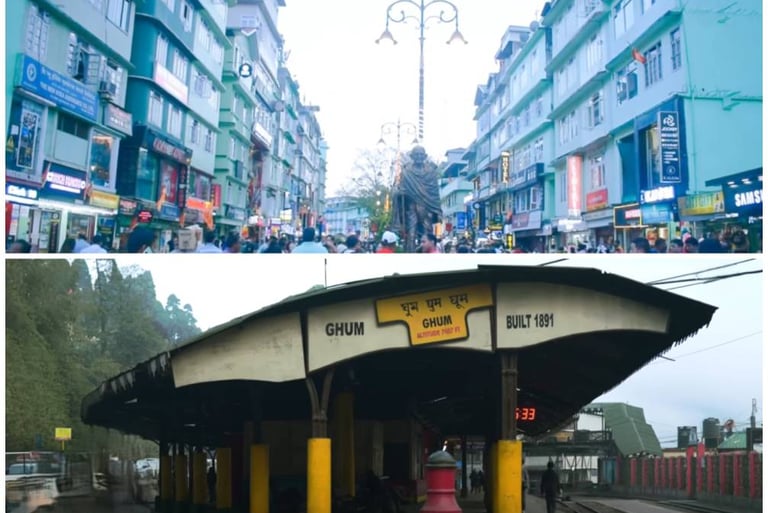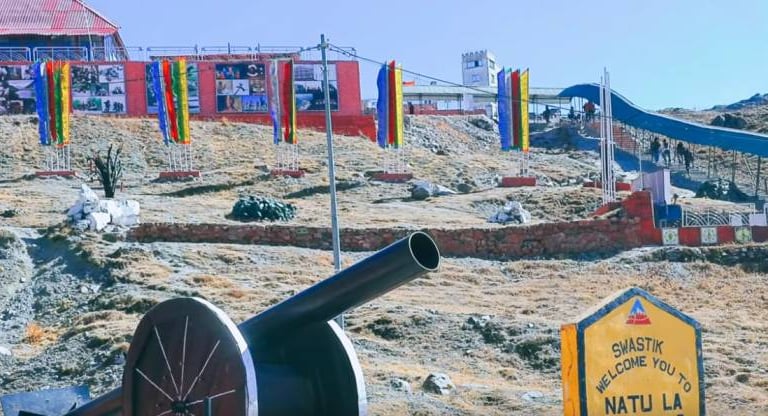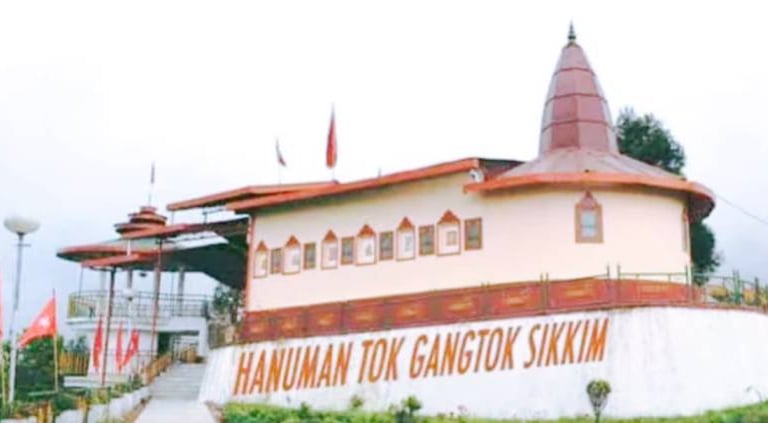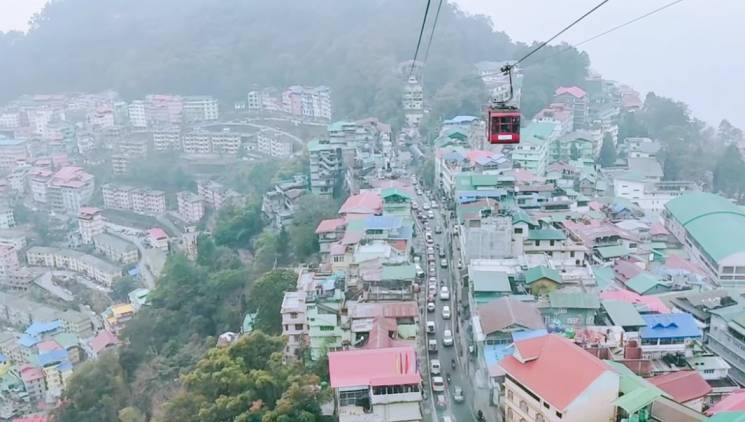Darjeeling vs Gangtok: Which Hill Station Should You Choose?
Compare Darjeeling vs Gangtok for your trip. Complete guide covering budget, attractions, weather, activities & accommodation. Choose the perfect Himalayan hill station for your travel style and preferences.
WEST BENGALSIKKIM
Arghyaraj Basu
6/29/202510 min read
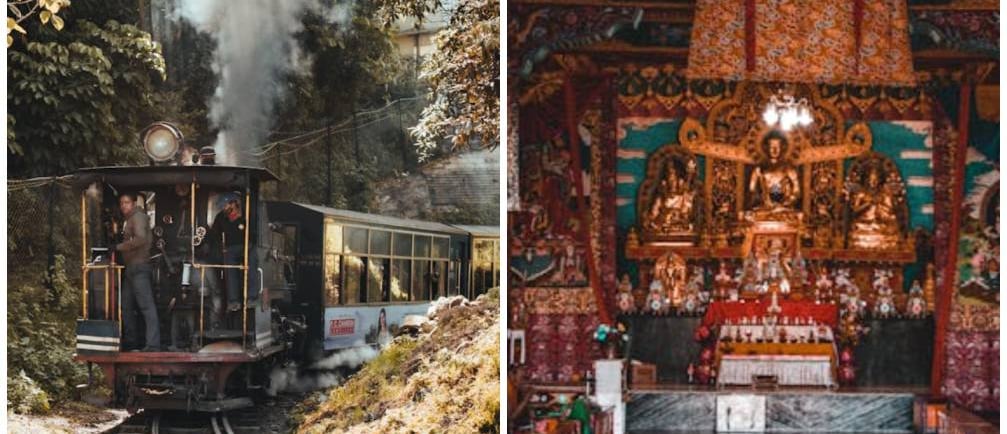

The Eastern Himalayas beckon with their majestic peaks, mist-shrouded valleys, and vibrant cultures. When it comes to choosing between Darjeeling and Gangtok for your next mountain getaway, it's a delightful dilemma. Both offer unique charm and unforgettable experiences, making the "better" choice entirely dependent on your travel style and preferences.
This comprehensive comparison will help you decide which Himalayan gem aligns perfectly with your dreams, offering a clear and honest look at what each destination brings to the table.
What Makes Each Special?
Darjeeling: The Queen of the Hills with a Colonial Heart
Step into Darjeeling, and you'll feel like you've been transported back in time. Its colonial-era architecture, rambling tea estates, and the iconic Toy Train evoke a nostalgic, old-world charm. The pace here is generally slower, inviting you to relax, sip on world-renowned Darjeeling tea, and soak in the serene mountain air. It's a place where you can unwind and appreciate the quiet beauty of the hills, perfect for heritage and nostalgia seekers. Its easy access with no permits needed makes it a hassle-free choice, especially for family-friendly trips, honeymooners, and older travelers.
Key Attractions & Experiences:
Tiger Hill: Witness the mesmerizing sunrise over Mount Kanchenjunga, and on a clear day, catch a glimpse of Mount Everest – a truly iconic view.
Darjeeling Himalayan Railway (Toy Train): A UNESCO World Heritage Site offering a whimsical journey through picturesque landscapes, a unique cultural experience.
Batasia Loop: An engineering marvel where the Toy Train takes a dramatic 360-degree turn, featuring a beautifully landscaped garden and a war memorial.
Peace Pagoda: A serene Buddhist shrine symbolizing peace and unity, offering panoramic views of Darjeeling town.
Padmaja Naidu Himalayan Zoological Park: Home to rare and endangered Himalayan species like the Red Panda, Snow Leopard, and Himalayan Black Bear.
Happy Valley Tea Estate: Take a guided tour to understand the art of tea processing and savor a fresh cup of the world-famous Darjeeling tea.
Ghoom Monastery (Yiga Choeling Monastery): The oldest Tibetan Buddhist monastery in Darjeeling, housing a magnificent 15-foot-high statue of Maitreya Buddha.
Chowrasta and Mall Road: The vibrant heart of Darjeeling, ideal for leisurely strolls, shopping for local crafts, and soaking in the town's lively atmosphere.
Himalayan Mountaineering Institute (HMI): Co-located with the zoo, it's a premier mountaineering institute with a fascinating museum chronicling mountaineering history.
Gangtok: The Modern Buddhist Haven & Adventure Gateway
Gangtok, the capital of Sikkim, offers a distinctly different feel. It's a cleaner, more organized city that beautifully blends modern urban life with ancient Buddhist traditions. MG Marg, the pedestrian-only main street, is a vibrant hub with cafes, shops, and a lively atmosphere, showcasing an organized and clean environment. Gangtok feels more contemporary, with a strong emphasis on spirituality and access to a wider range of high-altitude adventures, making it an ideal adventure gateway, especially for trips into North Sikkim (Lachen/Lachung).
Key Attractions & Experiences:
MG Marg: The vibrant, pedestrian-only main street and commercial hub, perfect for shopping, dining, and people-watching. It's renowned as India's cleanest pedestrian street.
Tsomgo Lake (Changu Lake): A sacred glacial lake surrounded by mountains, offering stunning beauty and opportunities for yak rides, especially enchanting in winter.
Nathula Pass: (Requires permits and is subject to opening) A high-altitude mountain pass connecting Sikkim with Tibet, offering dramatic snowy vistas at the Indo-China border.
Rumtek Monastery: One of the largest and most significant monasteries in Sikkim, a major center for the Kagyu lineage of Tibetan Buddhism, offering profound spiritual experiences.
Do Drul Chorten Stupa: A prominent Buddhist stupa with 108 prayer wheels, believed to ward off evil spirits.
Hanuman Tok & Ganesh Tok: Temples offering panoramic views of Gangtok and the surrounding Himalayan ranges.
Seven Sisters Waterfall: A beautiful cascading waterfall, particularly impressive during the monsoon season.
Namgyal Institute of Tibetology: A renowned institute dedicated to promoting Tibetan language, culture, and religion, housing a valuable collection of Buddhist scriptures and artifacts.
Himalayan Zoological Park: A well-maintained zoo focusing on Himalayan wildlife, including the Red Panda and Snow Leopard.
Ranka Monastery (Lingdum Monastery): A relatively new but architecturally beautiful monastery offering a peaceful ambiance away from the city bustle.
Heritage vs. Spiritual Heartbeat
Darjeeling: A Cultural Melting Pot
Darjeeling's cultural fabric is a rich tapestry woven with Nepali, Tibetan, and Bengali influences, all set against a backdrop of British colonial heritage. You'll find a mix of traditions reflected in its architecture, cuisine, and local festivals. Exploring the local markets and interacting with the diverse community offers a unique cultural insight. It's a place where British-era bakeries coexist with Tibetan food, all steeped in Nepali culture.
Gangtok: A Spiritual Heartbeat
Gangtok is deeply rooted in Sikkimese and Buddhist traditions. Monasteries like Rumtek and Enchey are central to its identity, offering profound spiritual experiences. The city promotes cleanliness and order, with MG Marg being a prime example of its well-planned urban spaces. It's a place where you can delve deeper into Buddhist philosophy and witness vibrant spiritual practices, enjoying Sikkimese food, clean cafes, and local craft.
Winner: Tie - Darjeeling for colonial heritage and tea culture; Gangtok for Buddhist monastery experiences.
Culinary Journeys: Colonial Comfort vs. Authentic Flavors
Darjeeling: Timeless Cafes and Hill Station Delights
Darjeeling boasts legendary old-world cafes like Glenary's and Keventer's, perfect for a cozy breakfast with a view. You'll find a delightful mix of colonial comfort food, freshly baked goods, and local favorites like steaming momos and thukpa. The emphasis is on classic hill station fare and the ubiquitous Darjeeling tea.
Must-try: Darjeeling tea, momos, thukpa, sel roti.
Gangtok: A Culinary Adventure
Gangtok offers a wider array of authentic Sikkimese cuisines, such as Phagshapa, Bamboo shoot curry, and Sel Roti. Its cafes often have a more contemporary feel, supporting local art and music, giving the city a youthful and experimental culinary vibe. If you're keen to explore unique regional flavors, Gangtok will be a treat for your taste buds.
Must-try: Gundruk, kinema, chhurpi, traditional Sikkimese thali.
Winner: Gangtok - for more diverse dining options and better restaurant quality.
Thrills & Tranquility: Gentle Trails vs. Adrenaline Pumping Activities
Darjeeling: Soft Adventures and Scenic Treks
Darjeeling offers softer adventure options. You can enjoy nature trails, picturesque tea garden walks, and treks like the Sandakphu trek, known for its panoramic views. Rock climbing at Tenzing Rock and seasonal paragliding are available. It's ideal for those who prefer gentle exploration and immersion in nature.
Gangtok: High-Altitude Thrills
For the adrenaline junkies, Gangtok is the clear winner. Here, you can indulge in river rafting on the Teesta and Rangit, exhilarating paragliding with stunning aerial views, snow play at Nathula Pass (when open), and even yak rides. If you're looking for high-octane adventure and don't mind the higher altitudes, Gangtok will satisfy your craving for thrills.
Winner: Gangtok - for more diverse and accessible adventure activities.
Navigating Your Journey: Accessibility & Permits
Darjeeling: Hassle-Free Travel
Getting there is straightforward. Darjeeling, being in West Bengal, generally requires no special permits for Indian or foreign tourists, making entry and movement relatively easy. It's well-connected by road from Siliguri/New Jalpaiguri (NJP) Railway Station (approx. 70 km, 2–3-hour drive) and Bagdogra Airport (approx. 68 km). Local transport includes shared jeeps and taxis, though walking is often part of the charm on its narrow, steep roads.
Gangtok: Permits and Planning
Getting to Gangtok from Bagdogra Airport (approx. 124 km) or NJP (approx. 148 km) takes about 4 hours on better-maintained highways. However, as the capital of Sikkim, Gangtok and many of its surrounding attractions (like Nathula Pass and North Sikkim) require Inner Line Permits (ILP) for foreigners and sometimes additional permits for Indians. This means a bit more planning and paperwork, but it also adds to the exclusivity of some of its more pristine areas. Local transport is more organized with ample taxis and a cable car system.
Winner: Darjeeling - for easier, permit-free access.
Budget Considerations
Darjeeling: Budget-Friendly Charm
Darjeeling is generally considered a more budget-friendly destination, with a wider range of affordable accommodation and dining options. Its established tourism infrastructure often allows for more competitive pricing.
Daily budget (per person): Budget traveler: ₹1,500-2,500; Mid-range: ₹3,000-5,000; Luxury: ₹6,000+.
Cost factors include tea garden tours and Toy Train rides.
Gangtok: A Bit More Premium
Gangtok can be slightly more expensive due to its unique geographical location, regulated tourism, and the permits required for certain attractions. However, it still offers a range of options from budget to luxury with generally more modern amenities.
Daily budget (per person): Budget traveler: ₹2,000-3,000; Mid-range: ₹3,500-6,000; Luxury: ₹7,000+.
Cost factors include permits for certain areas, higher accommodation costs, and adventure activity fees.
Winner: Darjeeling - slightly more budget-friendly overall.
When to Visit: Sunny Skies or Misty Monsoons?
Both: March–June (spring/early summer) and October–December (autumn/early winter) are considered the optimal times to visit both destinations due to pleasant weather and clear skies, ideal for sightseeing and outdoor activities.
Darjeeling: Experiences heavier rainfall during the monsoon (July-September), which can lead to roadblocks and limited views. Winter (December-February) is cold but offers very clear views.
Gangtok: Experiences moderate rainfall during monsoon (July-August) and transforms into a serene wonderland in winter (December-February), though higher altitudes may require permits for snow routes.
Winner: Similar seasons, but Gangtok offers slightly better weather consistency.
Which Should You Pick?
Your ideal Himalayan escape truly hinges on your travel style.
👉 Choose Darjeeling if you:
Love heritage, tea gardens, and easy logistics.
Want to experience the famous Toy Train and a more laid-back, nostalgic atmosphere.
Are seeking iconic Kanchenjunga sunrise views and gentle nature walks.
Are traveling on a slightly tighter budget.
Enjoy literary and historical connections, and the charm of a classic hill station.
👉 Choose Gangtok if you:
Seek adventure activities and outdoor experiences like rafting and paragliding.
Want consistent mountain views and a cleaner, more organized urban environment.
Prefer modern amenities and better infrastructure.
Are deeply interested in Buddhist culture and monasteries.
Plan to use it as a base for exploring other parts of Sikkim (like the breathtaking North Sikkim).
The Final Verdict: Why Not Both?
While this detailed comparison highlights their distinct personalities, the truth is, Darjeeling and Gangtok complement each other beautifully. If you have the time (around 5–7 days minimum, ideally 7-10 days), combining both destinations in a single trip offers a comprehensive Himalayan experience. They're only about 100 km apart (4–5 hours’ drive), making a combined itinerary very feasible.
Sample route: Bagdogra Airport / NJP Railway Station → Darjeeling (2-3 nights) → Gangtok (3-5 nights) → North Sikkim (optional, requiring more days).
For first-time visitors to the region: Gangtok often offers a more well-rounded experience with better facilities and a wider range of activities.
For culture and heritage enthusiasts: Darjeeling provides more historical depth and unique colonial and tea experiences.
For adventure seekers: Gangtok is the clear winner with diverse activities and better organization.
For budget travelers: Darjeeling offers more economical options without compromising on the authentic hill station experience.
Planning Tips for Your Himalayan Journey:
Book accommodation in advance during peak seasons for both destinations, especially in April-May and October-November.
Check weather conditions before traveling, particularly during monsoon (July-September) for Darjeeling due to potential landslides.
Carry layered clothing even in summer, as temperatures can drop significantly in the hills.
Keep permits ready for Gangtok (required for certain areas in Sikkim), especially for foreigners.
Plan for 3-4 days minimum in either destination to fully experience what they offer.
Whether you choose the tea-scented hills of Darjeeling or the monastery-dotted slopes of Gangtok, you're guaranteed an unforgettable Himalayan experience that will leave you planning your next mountain getaway. Choose wisely, and prepare to be enchanted!
Frequently Asked Questions (FAQs)
Q1: Which is better for a first-time visitor to the Eastern Himalayas - Darjeeling or Gangtok?
A: Gangtok is generally better for first-time visitors due to its superior infrastructure, consistent mountain views, and organized tourism facilities. However, if you're particularly interested in tea culture and colonial history, Darjeeling offers a more unique experience.
Q2: Can I visit both Darjeeling and Gangtok in one trip?
A: Absolutely! They're only 98 km apart (about 3-4 hours by road). A 6-7 day trip allows you to spend 2-3 days in each destination. Many travelers combine both for a complete Eastern Himalayan experience.
Q3: Which destination is more budget-friendly?
A: Darjeeling is slightly more budget-friendly, with accommodation and food costs averaging 15-20% lower than Gangtok. However, both destinations offer options for every budget range.
Q4: Do I need permits to visit Darjeeling or Gangtok?
A: No permits are required for Darjeeling. For Gangtok, you don't need permits for the main city, but you'll need Inner Line Permits (ILP) for places like Nathula Pass, Tsomgo Lake, and North Sikkim (Lachen/Lachung).
Q5: Which place has better weather throughout the year?
A: Both have similar weather patterns, but Gangtok has slightly more consistent conditions. Darjeeling can be foggier during monsoons, while Gangtok maintains better visibility. Both are best visited from March-May and September-December.
Q6: Is Darjeeling or Gangtok better for adventure activities?
A: Gangtok wins hands down for adventure tourism. It offers river rafting, paragliding, cable car rides, and serves as a base for treks to North Sikkim. Darjeeling has limited adventure options mainly focused on trekking.
Q7: Which destination offers better food experiences?
A: Gangtok has more diverse dining options with better restaurant infrastructure. Darjeeling excels in authentic tea experiences and has charming colonial-era bakeries, but Gangtok offers superior variety in cuisines and dining ambiance.
Q8: How many days should I spend in each place?
A: Darjeeling: 2-3 days are sufficient to cover major attractions including Tiger Hill, tea gardens, and the Toy Train. Gangtok: 3-5 days recommended if you plan to visit nearby attractions like Tsomgo Lake and explore monasteries thoroughly.
Q9: Which is better for photography enthusiasts?
A: Both are excellent for photography. Darjeeling offers iconic tea garden landscapes and colonial architecture, while Gangtok provides more consistent mountain views and colorful monastery scenes. Choose based on your preferred photography style.
Q10: Can I see Kanchenjunga from both places?
A: Yes, both destinations offer views of Kanchenjunga, but conditions vary. Darjeeling's Tiger Hill is famous for sunrise views, while Gangtok provides more consistent visibility of the peak throughout the day from various viewpoints.
Q11: Which destination is better for families with children?
A: Gangtok is more family-friendly due to better infrastructure, cleaner environment, and organized attractions. The cable car rides and zoo visits are particularly appealing to children. Darjeeling's Toy Train is also a big hit with kids.
Q12: What's the best way to travel between Darjeeling and Gangtok?
A: Shared taxis are the most common and economical option (₹200-300 per person). Private taxis cost ₹2,500-3,500. The journey takes 3-4 hours through scenic mountain roads. Book in advance during peak season.
Q13: Which place is better for solo travelers, especially solo female travelers?
A: Both are generally safe for solo travelers. Gangtok has better infrastructure and is more organized, making it slightly easier for solo travel. Both destinations have good connectivity and helpful local communities.
Q14: Is it possible to see snow in either destination?
A: Snow is rare in both main towns due to their altitudes. However, nearby higher-altitude areas like Sandakphu (from Darjeeling) and Nathula Pass (from Gangtok) receive snow during winter months (December-February).
Q15: Which destination offers better shopping opportunities?
A: Gangtok's MG Marg offers better shopping infrastructure with local handicrafts, woolens, and Sikkimese products. Darjeeling is famous for tea purchases and has charming local markets, but Gangtok provides more variety and organized shopping experiences.
